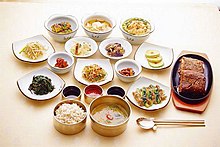
Back Bançan Azerbaijani বানচান Bengali/Bangla Banchan Catalan Banchan German Banchan Spanish Banchan French Pancshan Hungarian Banchan ID Banchan Italian パンチャン Japanese
| Banchan | |
 | |
| Korean name | |
|---|---|
| Hangul | 반찬 |
| Hanja | 飯饌 |
| Revised Romanization | banchan |
| McCune–Reischauer | panch'an |
| IPA | [pan.tɕʰan] |
| This article is part of a series on |
| Korean cuisine 한국 요리 조선 료리 |
|---|
 |
Banchan (/ˈbɑːntʃɑːn/ BAHN-chahn;[1] Korean: 반찬; Hanja: 飯饌; IPA: [pantɕʰan]) are small side dishes served along with cooked rice in Korean cuisine. Banchan are often set in the middle of the table to be shared. At the center of the table is the secondary main course, such as galbi or bulgogi, and a shared pot of jjigae. Bowls of cooked rice and guk (soup) are set individually. Banchan are served in small portions, meant to be finished at each meal and replenished during the meal if not enough. Usually, the more formal the meals are, the more banchan there will be. Jeolla province is particularly famous for serving many different varieties of banchan in a single meal.[2]
The basic table setting for a meal called bansang usually consists of bap (밥, cooked rice), guk or tang (soup), gochujang or ganjang, jjigae, and kimchi. According to the number of banchan added, the table setting is called 3 cheop (삼첩), 5 cheop (오첩), 7 cheop (칠첩), 9 cheop (구첩), 12 cheop (십이첩) bansang, with the 12 cheop used in Korean royal cuisine.[3] Note that kimchi is not included in the cheop count. People would have different amounts of banchan depending on their class; a king would have 12, with others usually having less.
- ^ Bhandari, Aparita (22 March 2017). "Learning how to eat banchan". Toronto Star. Retrieved 15 April 2017.
- ^ (in Korean) Hanjeongsik from Naver open dictionary, food columnist Lee JinRang (이진랑), 2005-07-17
- ^ (in Korean) Making a bansang from Doosan Encyclopedia